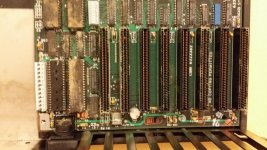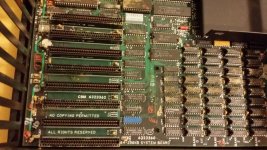FunctionalLimits
Experienced Member
I recently got an IBM 5160 from a local recycler. (Yes, apparently people are still taking these things to the recycler!) The exterior of the box looked pretty clean, so I figured it would be a quick and pleasant little weekend project to open it up, inspect it, get rid of the dust bunnies, and take it for a test drive. I'm sure I was humming cheerfully as I removed the case screws. Then I slid the top off and saw...something. There was very little dust, but there was a *lot* of mess: The RAM banks looked mossy, and the processor was yellow. At first I thought the machine must have been stored in a very humid environment, although I hadn't spotted any rust at all on the case. Then I noticed the little pellets of organic matter. Droppings! OK, this motherboard was somebody's latrine. Now all I could think about was removing the drives to make sure there wasn't a carcass lurking in or under them. There wasn't (big relief), but I can tell you that the previous inhabitant did spend some time hanging out in drive A. Drive B was remarkably unscathed.
Unfortunately, due to a certain loss of composure, I forgot to take commemorative photos of the motherboard in its fully glory. I did manage to get a couple of shots after the first scrub-down with brush and 99% isopropyl, although I guess I must have been a little shaky, because they're slightly blurred. :-/ I'll try to improve them later with Photoshop, but to give you an idea, here's the 8088 beginning to re-emerge; you may also notice some remnant poop still stuck to the board between the slots:

And here are the RAM banks looking much less furry:

Again, these were *after* I had already removed a *lot* of muck. I've cleaned this motherboard three times now using brushes, swabs, and alcohol, but there's still a fair amount of residual crud. There's also a lot of oxidation; even the expansion slots have areas that are green. (On the other hand, the connectors on the cards that were in them are fine.) Given the high filth factor on this board and the unusually tenacious properties of said filth, I really would like to give this thing a bath. I've heard/read lots of stories about motherboards going into the dishwasher, but I've never been tempted to try it. I don't even use a dishwasher for my dishes. However, I don't think I can clean this board without giving it a thorough soaking with agitation.
So here are my questions:
(1) Has anyone put an oldish board like this in the dishwasher? If so, was the experiment a success? What were the parameters (water temperature, board placement, drying method, soap)?
(2) Given all the oxidation already on this board, should I just avoid exposing it to water?
Thanks in advance for any tips. I don't know how much more manual poop-swabbing I can stand to do...
Unfortunately, due to a certain loss of composure, I forgot to take commemorative photos of the motherboard in its fully glory. I did manage to get a couple of shots after the first scrub-down with brush and 99% isopropyl, although I guess I must have been a little shaky, because they're slightly blurred. :-/ I'll try to improve them later with Photoshop, but to give you an idea, here's the 8088 beginning to re-emerge; you may also notice some remnant poop still stuck to the board between the slots:

And here are the RAM banks looking much less furry:

Again, these were *after* I had already removed a *lot* of muck. I've cleaned this motherboard three times now using brushes, swabs, and alcohol, but there's still a fair amount of residual crud. There's also a lot of oxidation; even the expansion slots have areas that are green. (On the other hand, the connectors on the cards that were in them are fine.) Given the high filth factor on this board and the unusually tenacious properties of said filth, I really would like to give this thing a bath. I've heard/read lots of stories about motherboards going into the dishwasher, but I've never been tempted to try it. I don't even use a dishwasher for my dishes. However, I don't think I can clean this board without giving it a thorough soaking with agitation.
So here are my questions:
(1) Has anyone put an oldish board like this in the dishwasher? If so, was the experiment a success? What were the parameters (water temperature, board placement, drying method, soap)?
(2) Given all the oxidation already on this board, should I just avoid exposing it to water?
Thanks in advance for any tips. I don't know how much more manual poop-swabbing I can stand to do...
